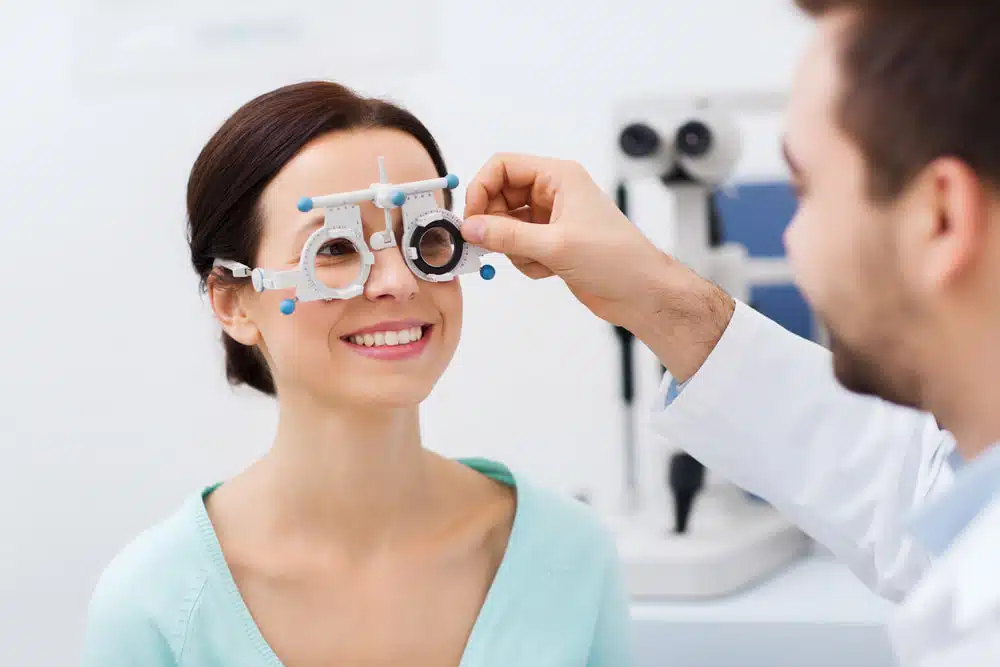Having regular eye exams done is an integral part of maintaining optimal eye health since many eye diseases don’t always have obvious symptoms or warning signs. Your optometrist will monitor your vision and look for any indications of disease including macular degeneration, glaucoma, and more. Routine eye exams will also include a series of different tests to check various aspects of your eyes, such as their colour vision and sharpness. Determining exactly how often you should have your eyes tested will vary depending on age, health conditions, family history, and whether or not you’re currently experiencing any issues with your vision. That’s why it’s always best to talk to your doctor so they can perform a preliminary test to determine how frequently you should be getting them tested.
If you’re wondering what goes on during a standard eye exam, we’ve got the break down on what you need to know below.
Contents
What a Standard Eye Exam Tests for:
Eye exams will generally test for the following:
- Visual acuity
- Visual field
- Movement of the eyes
- How light passes through your eyes
- Colour vision
- The condition of your entire eye structure
- The health of the retina
- Any risks or signs of disease
Paper Work and Introduction
As a new patient, you’ll be asked to fill out paperwork about your medical history, personal information, and any symptoms or issues you have experienced regarding your vision. Once you meet your doctor, they will take you into their office, look over your information, and ask about any symptoms or vision problems that could be impacting your sight.
General Vision Test with the Snellen Chart
Chances are you’ve experienced the Snellen Chart before with your regular family doctor as they sometimes perform this basic vision test with their patients. With a large chart of letters ranging in size, the doctor will ask you to place one hand over one eye and read out any letter they point at. Then you’ll do the same with the other eye. This tests the basic sharpness of your vision.
Refraction Test
Your doctor will then use a retinoscope or computerized vision-testing instrument by pointing a light at your eyes. This gives them an estimate on your prescription strength in correlation with your vision. As they monitor your vision, they’ll adjust the tool by placing different lenses in front of your eyes to determine which is best for giving you clear, sharp sight.
Testing Out Both Eyes
Similar to the Snellen chart, the doctor will also analyze how well your eyes work together more thoroughly using a tool called an occluder.
Colour Test
Seeing the world in colour is a luxury that many people don’t have due to a deficiency with their vision. To determine your scope of colour vision, this test will involve looking at cards with coloured dots that include numbers in them. The doctor will ask you whether you can see a number. If you can, then your colour vision is good, but if not, then they may need to perform more tests to determine why.
Testing for Glaucoma
Since glaucoma is such a common eye disease, optometrists will also test your eyes for any symptoms by performing the puff test. During this quick test, a little bit of air will be “puffed” into both of your eyes so the doctor can analyze the fluid pressure inside of them.
Taking a Closer Look
Sometimes during a standard eye exam, the doctor may also place eye drops in your eyes in order to dilate them and inspect them further. As the pupils dilate, it lets the optometrist dig deeper into your eyes to look for any signs or issues that may be of concern.
A Magnified View
To finish off the test, the doctor will use a slit lamp, also known as a biomicroscope. This nifty device magnifies the eyes, letting them see inside and in front of the eyes. This zoomed in scope allows them to also inspect for certain risks like diabetic retinopathy, cataracts, and more.
If it’s been longer than you can remember since you’ve had your eyes last checked, visit at Laurier Optical on Innes or contact us today to arrange an eye exam.
